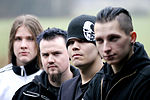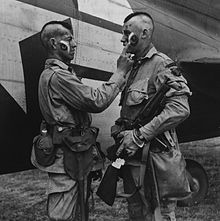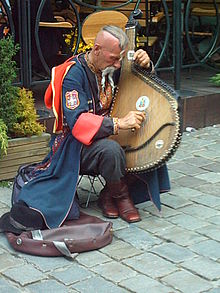- Mohawk hairstyle
-
"Iro" redirects here. For the former U.N. specialized agency, see International Refugee Organization."Euro hawk" redirects here. For the EuroHawk unmanned plane, see Northrop Grumman RQ-4 Global Hawk.
The mohawk (referred to in British English as a mohican -- although the mohican and mohegan are completely different tribes than the Mohawk and not associated therewith) is a hairstyle in which, in the most common variety, both sides of the head are shaven, (historically Indians did not shave their heads, but rather plucked the hair out) leaving a strip of noticeably longer hair in the center. Though mohawk is associated mostly with punk rock subculture, today it has entered mainstream fashion. The mohawk is also sometimes referred to as an iro in reference to the Iroquois, from whom the hairstyle is derived.
Contents
History
The mohawk hairstyle is named after, and often associated with, the people of the Mohawk nation, an indigenous people of North America who originally inhabited the Mohawk Valley in upstate New York.[1] However, the Mohawk tribe never actually wore the Mohawk hairstyle traditionally. The association with the so-called "Mohawk" hairstyle and the Mohawk tribe came from Hollywood and more specifically from the 1936 movie, Drums Along the Mohawk starring Henry Fonda.
The historic evidence points to the Mohawk and the rest of the Iroqoius confederacy (Seneca, Cayuga, Onandaga, Tuscarura and Onieda) rather wore a square of hair on the back of the crown of the head, and not a crest from forehead to the nape of the neck. Click here for accurate images of Mohawks and Oniedas 1710-1790 from life drawings (note: none have "Mohawks"); look at Good Peter, Oneida - though he has a true Mohawk, i.e. a square of hair on the back crown of the head. The Mohawk did not shave their heads when creating this square of hair, but rather pulled the hair out, small tufts at a time. The following is a first-hand account of James Smith who was captured during the French and Indian war and adopted into the Mohawk tribe. "...a number of Indians collected about me and one of them began to pull hair out of my head. He had some ashes on a piece of bark in which he frequently dipped his fingers in order to take a firmer hold, and so he went on as if he had been plucking a turkey, until he had all the hair clean out of my head, except a small spot about three or four inches square on my crown the remaining hair was cut and three braids formed which were decorated ...".
Therefore a true Mohawk hairstyle was one of plucked-out hair, leaving a three-inch square of hair on the back crown of the head with three short braids of hair decorated. The three braids of a True Mohawk hairstyle are represented today on traditional headdresses of the Mohawk known as a "Gustoweh". Mohawk Gustoweh's have three upright eagle feathers that represent the three braids of long ago. Click here to see Gustowehs. When not decorated, the very short braids were allowed to hang loose as seen in Good Peter's image in the above-linked article.
Historic images do show Omaha men, and yet other images show Pawnee children with a crest of hair. John White painted the Indians on Roanoke Island in 1600 with a crest of hair in combination with long hair on each side. Perhaps the "Mohawk" should rather be coined a "Omaha" or "Pawnee". Ironically, Mohawk Indians never had Mohawk hairstyles as modern society has come to know them. This misunderstanding of history has become so buried in mainstream society that even Mohawk Indians have come to accept that their ancestors wore this, hairstyle even though historic records, sketches, and paintings clearly prove they did not. However, modern society's motto is. "Once it's in a movie, that's the way it happened".
The hairstyle has been in existence in many parts of the world for millennia. For instance, the Clonycavan Man, a 2000-year-old male bog body discovered near Dublin in 2003, was found to be wearing a mohawk styled with plant oil and pine resin.[2] Artwork discovered at the Pazyryk burials dating back to 600 BCE depicts Scythian warriors sporting similar mohawks. The body of a warrior occupying one of the kurgans had been scalped earlier in life and wore a hair prosthesis in the form of a mohawk.[3]
When going to war, 16th-century Ukrainian Cossacks would shave their heads, leaving a long central strip. This haircut was known as a khokhol and was often braided or tied in a topknot.[4]
During World War II, many American GIs, notably paratroopers from the 101st Airborne Division wore mohawks to intimidate their enemies. It was also seen during the Vietnam War. In the early 1950s some jazz musicians, and even a few teenage girls, wore them.[5]
Style and maintenance
Depending on how it is worn, the mohawk can be a high-maintenance style. Regular, careful shaving or trimming is required to maintain a clean line between the shaven and unshaven (or short and long) portions of the hair; this can be especially complicated in bi and tri hawks.
If the hair is to be worn up, brushing, backcombing, blow-drying, and twisting are required, as well as the application of sprays and in some cases other holding agents like white or clear glue, egg whites, cornstarch, or gelatin. The amount of time required for styling may increase considerably with longer hair or complicated styles such as liberty spikes (sometimes known as a libertyhawk).
Some wearers enhance the look of their mohawks with hair dyes. This too can require a great deal of initial effort and maintenance, especially in styles where the color(s) form an integral part of the style. In some cases, for example, mohawk-wearers who normally wear their hair up in a fan style dye the hair in even lines or stripes of color, either horizontal or vertical.
Varieties
Although a mohawk is most widely defined as a narrow, central strip of upright hair running from the forehead to the nape, with the sides of the head shaven,[6][7] the term can be applied more loosely to various similar hairstyles, many of which have informal names.
 Wattie Buchan of the UK punk band The Exploited sporting a dreadhawk
Wattie Buchan of the UK punk band The Exploited sporting a dreadhawk
 The man on the right has a psychobilly mohawk
The man on the right has a psychobilly mohawk
Mohawks can be styled in a variety of ways. A "deathhawk" features voluminous teased hair, and is common to the deathrock and goth subcultures. A dreaded mohawk is a "dreadhawk". A mohawk styled like a fan is a "fanhawk". A "frohawk" is occasionally seen on African American punks, ravers, and old-school hip-hop fans. Some include hair twists on the side, cornrows, or just pinning up the sides. This style, originally the traditional haircut for warriors of the African Mandinka tribe, was popularized by actor, wrestler, and rapper Mr T.
"Liberty spikes" are spikes of hair in the mohawk instead of a row. The spikes can be of a single color, or dyed various colors. Bright colors are common, but when this style is worn by members of the goth subculture, it may be dyed in darker tones. The term also applies to this style when it is worn over the entire scalp. The "psychobilly mohawk" or "quiff" is the most common haircut for fans of psychobilly. It is in essence a pompadour with the sides shaved, similar to the haircut British National Service recruits received during basic training in the 1950s. A "rayhawk" is a short mohawk dyed bright blue; it is named due to the popularity of the style among Tampa Bay Rays players. The style has become popular among 'Rays fans. A "warhawk" is a very short mohawk (0–3 inches). Examples include videogame characters Joseph Turok and John "Soap" McTavish, fictional taxi driver Travis Bickle, mixed-martial artist Chuck Liddell, and singer Ivan Moody. A "lazy hawk" is a typical Mohawk, except left unstyled, resting on the wearer's head, and can be seen in The Marvel Comics character Daken (Wolverine's son), who is shown since his birth with a mohawk (long with the sides shaven). A mohawk with bangs, generally popular with females, is called a Chelsea hawk.
Mohawks or mohawk-like hairstyles can be cut in patterns deviating from the simple central strip. For example, a mohawk with multiple parallel strips of hair may be called a "bi-hawk" (for two strips), a "tri-hawk" (for three strips), etc. A hairstyle resembling a sideways mohawk, such as one that runs from ear to ear or temple to temple, is called a "crosshawk". A wide mohawk extending almost to the temples is referred to as a "shark fin". Shark fins are popular among the British chav and raver subcultures. The back is sometimes shaved into a V-shape and it is usually spiked and bleached blond. This is also known as a "V-cut mohawk". A similar haircut is worn by some emo and pop-punk fans. A mohawk that starts on the occiput and runs down into a rattail is a "rat-hawk". Rather than the strip of longer hair in the center of the scalp, a "reverse mohawk", or "nohawk", or "hawkmo" features a shaved strip from the forehead to the nape of the neck leaving hair on either side of the line. Small sections of hair left at the side of the head, just in front of the ears are known as Deathlocks (or devil locks), and are normally associated with the deathhawk style.
A fauxhawk copies the style of a mohawk, but without shaving the sides of the head.[8] The fauxhawk is typically worn with a small but noticeable spike in the middle, though usually considerably shorter than many traditional mohawks. The style re-emerged in the early 2000s, with one of the popularly known wearers being David Beckham. The fauxhawk is known in the Hoxton and Shoreditch districts of London as the "Hoxton fin".[9]
A fauxhawk where the hair down the center of the head is longer than the hair on the sides is a "euro-hawk". Sometimes the top of the hair is long enough to cover up the shorter sides when combed down.
Unlike traditional mohawks, which are worn straight, fauxhawks and euro-hawks can also be worn in a naturally curly hairstyle. Some of the more popular sports figures and fashion models can be found wearing euro-hawks in various lengths, textures and colors. The mohawk has been a style mostly seen on punk rockers and the like, but fauxhawks and euro-hawks have transcended to all hair types.
The ponyhawk or pony hawk is a type of euro-hawk created by a row of ponytails going down the middle of the head. This look was worn by contestant Sanjaya Malakar on an episode of the television series American Idol.[10]
A "curly hawk" or "curl-hawk" is similar to the fauxhawk, this lesser known hawk is in traditional faux style but consists of long thin curls. Having been made famous by Mary-Kate and Ashley Olsen during the early years of Full House, this is most commonly sported by infants.
See also
- List of hairstyles
- Roach (headdress)
References
- ^ Facts for Kids: Mohawk Indians (Mohawks)
- ^ "Ireland Bog Bodies". Yahoo! News. Archived from the original on 2006-08-18. http://web.archive.org/web/20060818023351/http://news.yahoo.com/s/nm/20060801/od_nm/ireland_bogbodies_dc. Retrieved January 2006.
- ^ [* S.I. Rudenko, Kul'tura naseleniia Gornogo Altaia v skifskoe vremia ("The Population of the High Altai in Scythian Times")(Moscow and Leningrad, 1953) translated as Frozen Tombs of Siberia: The Pazyryk Burials of Iron Age Horsemen, M.W. Thompson, tr. (University of California Press, Berkeley) 1970. ISBN 0-520-01395-6]
- ^ [1. ^ Thompson, Ewa Majewska (1991). The Search for self-definition in Russian literature. 27. John Benjamins Publishing Company. pp. 22. ISBN 9027222134. ]
- ^ UCLA Digital Collection
- ^ http://education.yahoo.com/reference/dictionary/entry/Mohawk_2
- ^ http://www.oxforddictionaries.com/definition/Mohican
- ^ "Word Spy: fauxhawk", Word Spy, September 2003, webpage: WSpy-fauxhawk
- ^ "Where have all the cool people gone?", The Guardian, November 21, 2003 (link)
- ^ "Ryan Seacrest Gets Everyone Laughing".
Categories:- Hairstyles
- Native American culture
- Gothic fashion
- Punk fashion
- 1970s fashion
- 1980s fashion
- 1990s fashion
- 2000s fashion
Wikimedia Foundation. 2010.





